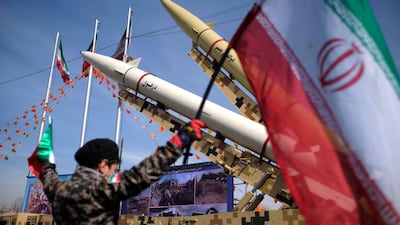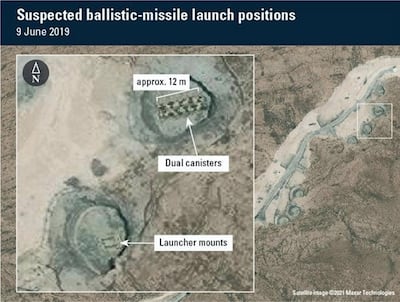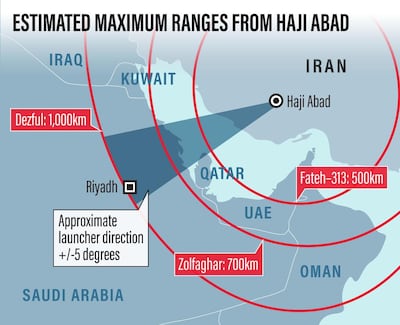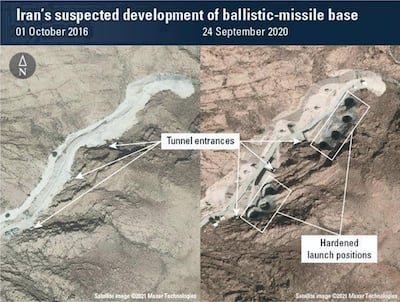Analysis of satellite imagery obtained by the International Institute for Strategic Studies revealed the construction of a new set of seven silos storing advanced new missiles in southern Iran.
Defence analysts at the IISS told The National the storage facility is placed on a steep mountainside and is designed to hold dozens of the weapons at a particular slant, for precision targeting of the missiles.
The imagery given to The National shows the bank of launch sites set into mountainous terrain close to the southern Iranian town of Haji Abad. The steep mountainside and particular slant of the seven silos strongly point to a limited direction that would cause concern for military airbases in Saudi Arabia and Bahrain.
The Haji Abad base has at least 14 of the latest Zolfagar or Dezful missiles that can be accurate to within 10 metres, carrying a 350 kilogramme warhead. It is understood dozens more weapons are stored at the base.
The new development underpins concerns over Iran’s growing stockpile of solid-fuel rockets that allows it to fire the weapons in a matter of minutes rather than the lengthy period required to prepare liquid-fuelled missiles.
The potential threat comes from analysis of satellite imagery and other information gathered by experts at the IISS on the suspected Islamic Revolutionary Guard Corps' (IRGC) missile base.
Satellite pictures show the missile canisters recessed in a steep mountainside "pointing very consistently" to large areas of Saudi Arabia, "potentially Riyadh", said IISS defence analyst Joe Dempsey, who led the study. The target area also covers a number of military bases, including a large US Air Force logistics hub.
“This hardened site is particularly interesting as it’s the first one that's been developed specifically to launch their solid fuel missiles,” the analyst said. “We also believe it’s for their longer-range missiles, based on a number of factors.”
The silos have five-metre thick walls “complementing what is already challenging terrain for an attack”, with a steep-sided valley, the IISS report states.
The base offers the IRGC the potential for “quick reaction” and “increased accuracy” by having a fixed position.
The launchers face south-west and are estimated to be in the range of 238 to 243 degrees, a bearing that takes in Riyadh and Bahrain. It is unclear whether they can be rotated for objectives elsewhere, or if they are trained to a specific selection of targets.
“The corresponding reduction of launch-preparation time – from what can be hours for a liquid-fuelled missile to minutes for solid propellants – and other operational advantages are driving Iran’s efforts to move away from a reliance on liquid-fuelled missiles,” Mr Dempsey wrote in his report.
The new base was reportedly completed in December 2019, with seven large hollow circular structures for pairs of missiles that are understood to be accessible via underground tunnels.
The intelligence showed that each silo contained pairs of cylindrical objects measuring about 12 metres in length, which were partially camouflaged. "Given their characteristics and protected placement, these may well be ballistic-missile launch canisters mounted horizontally," the report said.
The Zolfagar missile, introduced in 2016, can reach targets 700 kilometres away, putting Bahrain and several Saudi coastal targets within reach. Its accuracy, guided by satellite-based navigation, was proven in January last year when about 11 missiles struck US forces at the Ayn al Asad air base in Iraq, in retaliation for the killing of IRGC commander Qassem Suleimani. It was also successfully used in Syria in 2017.
The more modern Dezful missile appeared in 2019 and Iran claims it has a 1,000km range, bringing further targets within its scope.
Once launched, the missiles have a degree of manoeuvrability, but not enough to make them diverge significantly, so they are unlikely to threaten targets further to the south or north.
However, the silos are potentially vulnerable to “top-down aerial strikes” from modern weapons held by American and other air forces. It was therefore unclear why Iran had not attempted to put shields over the missile sites to protect against intelligence-gathering satellites.
There was a possibility that the site could be a "sophisticated subterfuge" Mr Dempsey told The National, but this was unlikely.
The potential new silo system might be an idea gathering wider appeal among Iran’s military commanders, with a similar structure to Haji Abad found 100km to the south at Khorgu, near Bandar Abas, and a potential site farther north, close to Shiraz.
The regional significance of Iran’s missile capability means the missile bases will “continue to attract attention from the intelligence community”, the IISS said, and further analysis will be made of the rationale behind the new structures.





